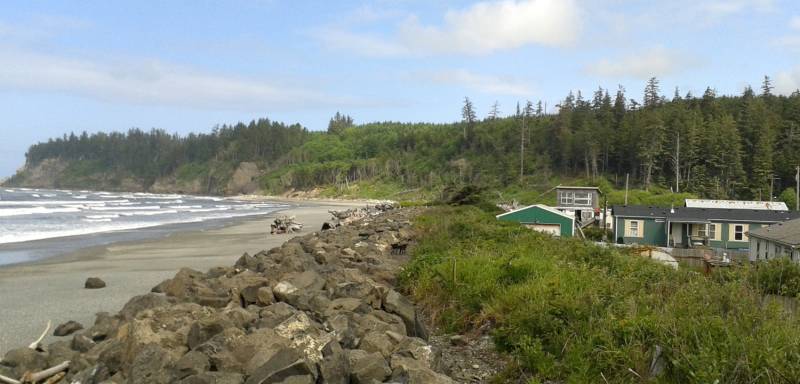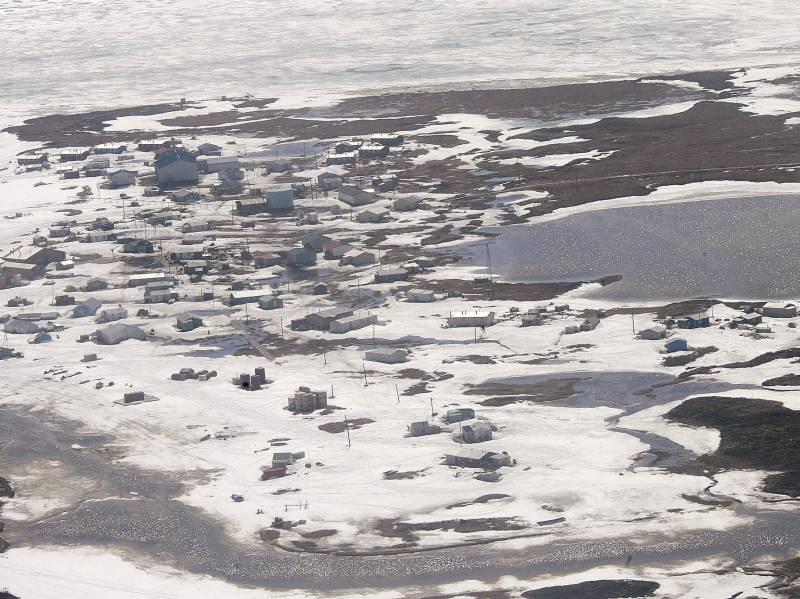The tribe has more than 3,000 members, “and over half of them live in these villages,” Capoeman told NPR. “Getting them up up on the hill is critical for us.”
The new funds will go towards moving the community’s most critical buildings. Down the line, Quinault’s plan is to develop new homes and a school.
 In this photo taken May 28, 2014, houses in the village of Taholah, on the Quinault Indian Reservation on the Pacific are shown at right. Repairs were made to the storm-damaged seawall that protects the village back in 2014, but continued erosion is forcing the community to move elsewhere. (Doug Esser/AP)
In this photo taken May 28, 2014, houses in the village of Taholah, on the Quinault Indian Reservation on the Pacific are shown at right. Repairs were made to the storm-damaged seawall that protects the village back in 2014, but continued erosion is forcing the community to move elsewhere. (Doug Esser/AP)
Every bit of funding helps in this massive endeavor, Capoeman said.
The community started their process more than 12 years ago, even before Capoeman became the nation’s president, he said.
“I just picked it up as I came on board and worked with our council, our lobbyist and other people and getting the message out that this is a need. We’re here at ground zero of the very climate change everybody’s talking about,” he said.
The tribe is extremely vulnerable to rising sea levels, flooding, potential tsunamis and other storm surges. Capoeman noted the community is also at particular risk of a potentially big earthquake as the village sits right along the Cascadia subduction zone. That fault line runs for hundreds of miles off the coast of the Pacific Northwest and has been building up pressure for years.
Earlier this year, the Newtok Village experienced a typhoon that knocked out 40 feet of land between the village and the Ninglick River.

The village is suffering from serious coastal erosion from storms, just like the one earlier this year, and degrading permafrost, according to the Interior Department.
“At the current rate of erosion of approximately 70 feet per year, the river is expected to threaten structures within two years and the village’s critical infrastructure within four years,” the department said.
Napakiak is dealing with such serious erosion that its school, fuel farm, water supply well, airport, homes and other critical infrastructure are at risk.
“The ongoing erosion is estimated to be 25-50 feet per year. Most of the current critical infrastructure is expected to be destroyed by 2030,” the Interior Department said in a news release.
The village has already established a 50-year, $200 million plan for managing relocation. Alaska Public Media reported last year that, in the next 10 years, “Napakiak will have to build the new school and move 38 homes, the store, the multi-purpose building, the water plant, and other structures.”
In addition to the three tribes receiving $25 million, eight additional communities will also receive $5 million, the Interior Department said.
Those include:
- Native Village of Point Lay (in Alaska)
- Huslia Village (in Alaska)
- Native Village of Fort Yukon (in Alaska)
- Native Village of Nelson Lagoon (in Alaska)
- Havasupai Tribe (in Arizona)
- Yurok Tribe (in California)
- Chitimacha Tribe (in Louisiana)
- Passamaquoddy Indian Tribe (in Maine)
Undergoing such a transformative move upends many of these communities’ ties to tradition, Capoeman said. For example, the Quinault have lived by the water for centuries in order to fish and gather clams.
“We’ve lived off the land and resources for thousands and thousands of years. We can see the changes. These tides that are coming in are not normal,” he said. “To take ourselves away from that is not traditional, but we have to save ourselves. We realize that it’s the key to our very own survival at this point.”
Copyright 2022 NPR. To see more, visit https://www.npr.org.9(MDAxOTAwOTE4MDEyMTkxMDAzNjczZDljZA004))

















